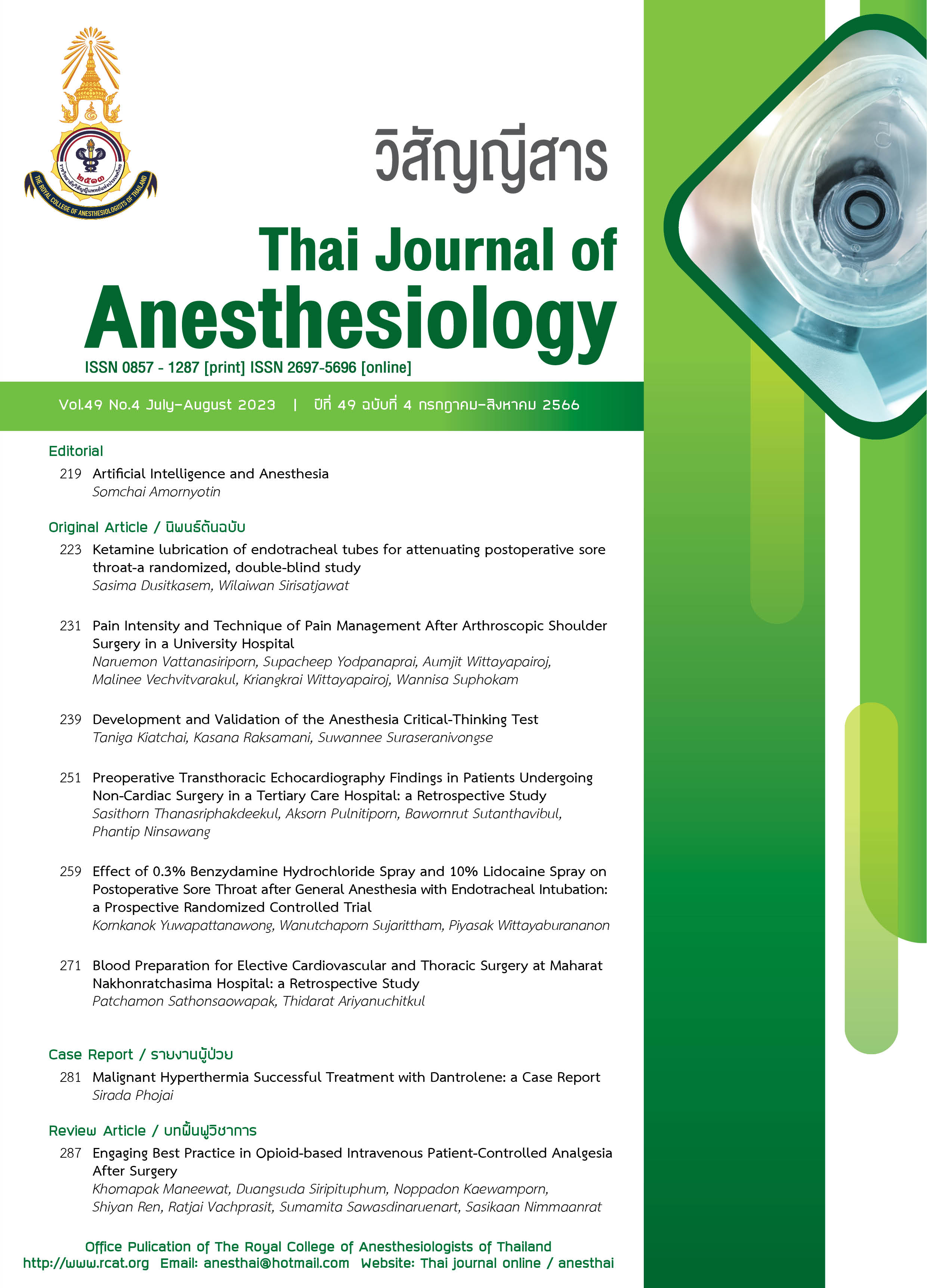Malignant Hyperthermia Successful Treatment with Dantrolene: a Case Report
Main Article Content
Abstract
Malignant hyperthermia (MH) is a pharmacogenetic disease of striated muscle induced by exposure to inhalational agents and succinylcholine, which can lead to serious anesthetic complications and even death. However, the mortality rate has decreased due to increased awareness for early diagnosis and prompt treatment with dantrolene. This case report described a 38-year-old Thai woman with no history of medical disease, who was admitted for total laparoscopic hysterectomy. Anesthetic induction was performed with propofol and morphine, followed by succinylcholine-facilitated trachea intubation. The patient showed neck stiffness (without masseter spasm), but tracheal intubation was successful with a video laryngoscope on the first attempt. Anesthesia was maintained with desflurane and cisatracurium. The earliest signs were hypercarbia (EtCO2 56-118 mmHg), followed by hyperthermia (max 41°C) and tachycardia. When MH was suspected, desflurane was stopped, and the patient was successfully treated with specific treatment with dantrolene, cooling as well as corrected acidosis and hyperkalemia. This case highlights the importance of early recognition, diagnosis, and prompt treatment of MH to prevent severe complications.
Article Details

This work is licensed under a Creative Commons Attribution-NonCommercial-NoDerivatives 4.0 International License.
References
อริศรา เอี่ยมอรุณ. Malignant hyperthermia. ใน: อังกาบ ปราการรัตน์, วรกา สุวรรณจินดา. ตำราวิสัญญีวิทยา, พิมพ์ครั้งที่ 3, กรุงเทพฯ; กรุงเทพเวชสาร. 2548.
Ording H. Incidence of malignant hyperthermia in Denmark. Anesth Analg. 1985;64:700-4.
Rosenberg H, Pollock N, Schiemann A, Bulger T, Stowell K. Malignant hyperthermia: a review. Orphanet J Rare Dis. 2015;10:93.
Larach MG, Gronert GA, Allen GC, Brandom BW, Lehman EB. Clinical presentation, treatment, and complications of malignant hyperthermia in North America from 1987 to 2006. Anesth Analg. 2010;110:498-507.
Acosta ISM, de Cos GV, Fernández MT. Malignant hyperthermia syndrome: a clinical case report. EJIFCC. 2021;32:286-91.
Rosenberg H, Brandom BW, Sambuughin N. Malignant hyperthermia and other inherited disorder. In: Paul GB, Cullen BF, Robert KS, Cahalan MK, M. Christine S, editors. Clinical anesthesia. 6th ed. Philadelphia; Lippincott Williams & Wilkins. 2009;p599-622.
Da Silva HCA, Ferreira G, Rodrigues G, et al. Profile of malignant hyperthermia susceptibility reports confirmed with muscular contracture test in Brazil. Braz J Anestesiol. 2019;69:152-9.
Gronert GA, Antognini JF, Pessah IN. Malignant Hyperthermia. In: Miller RD, editor. Anesthesia, 5th ed. New York; Churchill Livingstone. 2000;p1033-52.
Hopkins PM, Girard T, Dalay S, et al. Malignant hyperthermia 2020: Guideline from the Association of Anaesthetists. Anaesthesia. 2021;76:655-64.


